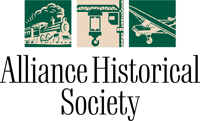#21. Glamorgan Castle, Col. Morgan’s Home

Glamorgan Castle
Alliance’s most magnificent home is Glamorgan, the residence built by Colonel William H. Morgan, president of the Morgan Engineering Company. It is named for the historic county in Wales where the Morgan family originated. Built between 1904 and 1905, the construction cost was about $400,000. Often called Glamorgan Castle, or the Morgan Mansion, the building, though a completely new construction at the time, is reminiscent of a traditional Welsh castle. The architect was Willard Hirsh of the firm Searles, Hirsh & Gavin of Cleveland. (Mr. Hirsh also designed the First Presbyterian Church on Market and the homes of Frank Dussel and O. F. Transue.) The exterior walls of the Castle are more than three feet thick at the base, and it took 96 train car loads of Vermont marble to complete the project. When it was built, the home had nearly 50 rooms, and was decorated with molded plaster, hand carved woodwork, inlaid floors, and silk tapestries. The interior style was quite eclectic: the rotunda was Italian Renaissance; the living room was French Empire; the reception room, Louis XV; the dining room, Elizabethan; the breakfast room, Japanese; and the card room, Moorish. The home had its own electric power plant to supply electricity, a built-in vacuum system, and a door annunciator and telephone system. It had a ballroom on the third floor, a magnificent domed rotunda, and a basement rathskeller, pool, and bowling alley. There was also a pipe organ from the 1904 St. Louis Exposition. (This organ was destroyed in an electrical fire that damaged the rotunda in 1944.)
Colonel Morgan died in 1928, and Mrs. Morgan sold the estate to the Elks in 1939 for $25,000. The family was happy to find a buyer given the depressed economy, as the alternative might have been to raze the structure. The Elks utilized Glamorgan as their “Elks Home” until about 1964 when they found it too expensive to maintain. The Elks began building a new lodge on 10 acres at the western end of the original property; they sold the rest of the land, including the Glamorgan Castle, to Hilltop Realty Company.
Many feared that the building would be torn down to make way for a shopping center or strip mall after the sale. Luckily, several leading businessmen came up with a plan to save the property. It was proposed that the City of Alliance would purchase the property from Hilltop in 1965; 14 acres in front of Glamorgan Castle would be kept for park land; 22 acres behind the Castle would be sold to the school board for the construction of a new Alliance High School; and a 3.5 acre parcel with Glamorgan Castle would be sold. The buyer of the last parcel was Alliance Machine Company. The Castle served as Alliance Machine’s headquarters, and president Merrick Lewis worked at restoring the building. He also bought the 14 acres of land in front of the castle. Unfortunately, the recession in the early 1970s necessitated that Alliance Machine sell the castle and adjacent property. It was proposed that the school board consider occupying the Castle as an administrative headquarters; once again the local community stepped up to raise funds. In 1972, Glamorgan Castle was added to the National Register of Historic Places, making the building eligible to receive federal grant funding. These grant funds and local matching funds made it possible for the Alliance City School District to acquire the Glamorgan Castle from Alliance Machine in 1973. Glamorgan continues to house the administrative offices of the district. A nonprofit organization called the Castle Crusaders assists the school board with the maintenance and preservation of the historic building and grounds. The group does fundraising, tours, and research in addition to renovations. The most recent capital campaign has been funding renovations to the building’s exterior, weatherproofing, temperature controls, and the addition of a new elevator.
In 2012, Glamorgan Castle was named as a Local Historic Landmark by the Alliance Historic Preservation Commission. Long may this iconic symbol of Alliance remain a part of our landscape.
